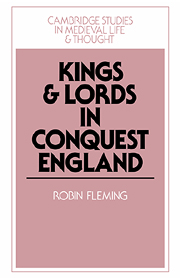Book contents
- Frontmatter
- Contents
- List of figures
- List of tables
- Preface
- List of abbreviations
- PART I CNUT'S CONQUEST
- PART II THE NORMAN CONQUEST
- 4 Domesday Book and the tenurial revolution
- 5 Territories and time
- 6 Private enterprise and the Norman settlement
- 7 Aristocratic landholding and royal power in the eleventh century
- Bibliography
- Index
7 - Aristocratic landholding and royal power in the eleventh century
Published online by Cambridge University Press: 09 October 2009
- Frontmatter
- Contents
- List of figures
- List of tables
- Preface
- List of abbreviations
- PART I CNUT'S CONQUEST
- PART II THE NORMAN CONQUEST
- 4 Domesday Book and the tenurial revolution
- 5 Territories and time
- 6 Private enterprise and the Norman settlement
- 7 Aristocratic landholding and royal power in the eleventh century
- Bibliography
- Index
Summary
Contemporary chroniclers found the relationship between Edward the Confessor and his great lords prior to 1066 and that of William I and his barons in the decades after to be compelling subjects. Edward's eulogy in the Anglo-Saxon Chronicle was fashioned around the king's piety and his relations with those who helped him rule. It described the king as a ‘ruler of heroes’, ‘strong in council’ and ‘loyally’ obeyed. The Conqueror's eulogist was struck most forcibly by the king's parsimony and his greed, but he was impressed nonetheless with William's ruthless ability to make the mighty heed his will, describing him as ‘so very stern and violent a man, that no one dared do anything contrary to his desire. He had earls in his fetters, who acted against [him].’ These final portraits present a highly stylized picture of strong monarchs and obedient lords, but there are also numerous accounts from each reign of aristocratic disaffection and revolt. Ambiguous and elusive, the narrative sources alone provide neither a straightforward assessment of royal power in the eleventh century nor the information necessary to judge whether England's most important aristocrats had resources sufficient to allow them to follow a strictly independent and self-interested course. Evidence in Domesday Book, however, furnishes both.
- Type
- Chapter
- Information
- Kings and Lords in Conquest England , pp. 215 - 231Publisher: Cambridge University PressPrint publication year: 1991



